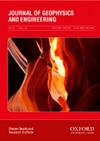用短偏移瞬变电磁法研究城市活动断层——以河北顺平为例
IF 1.7
3区 地球科学
Q3 GEOCHEMISTRY & GEOPHYSICS
引用次数: 1
摘要
城市活动断层的存在带来了威胁城市建设的地质灾害风险。因此,检测此类故障对于降低潜在风险和确保城市安全发展至关重要。接地线源短偏移瞬态电磁法(SOTEM)为识别高导电性故障提供了机会。介绍了在河北省顺平市进行的SOTEM调查结果,以探测埋藏断层并定位工业园区。利用SOTEMsoft软件,采用一维反演方法对数据进行分析,并采用基于小波阈值的短时滑动窗自适应奇异值分解算法对数据进行去噪。尽管城市特征,特别是交通带来了挑战,但调查结果定位了断层,并具有揭示其范围和深度的巨大潜力。该研究强调了在城市建设过程中避开断层现场的重要性,尽管该地区目前构造稳定。这篇论文为研究电磁方法在探测城市埋藏断层和揭示第四纪地层覆盖的地质结构方面的有效性提供了一个难得的机会。本文章由计算机程序翻译,如有差异,请以英文原文为准。
Investigation of urban active faults using the short-offset transient electromagnetic method: An example from Shunping, Hebei Province, China
The presence of an urban active fault carries a geological hazard risk that threatens urban construction. Therefore, detecting such faults is crucial for mitigating potential risks and ensuring safe urban development. The grounded-wire source short-offset transient electromagnetic method (SOTEM) offers an opportunity to identify faults with high-conductivity. The results of a SOTEM survey conducted in Shunping, Hebei Province, were presented to detect buried faults and locate the industrial park. Data were analysed using the one-dimensional inversion method with SOTEMsoft software, which was denoised using the short-time sliding window adaptive singular value decomposition algorithm based on the wavelet threshold. Despite the challenges posed by urban features, particularly traffic, the survey results located the fault and hold significant potential to reveal its extent and depth. The study highlights the importance of avoiding fault sites during urban construction, even though the area is currently tectonically stable. This paper reveals an unusual opportunity to study the effectiveness of electromagnetic methods for detecting buried faults in cities and reveal geological structures covered by Quaternary formations.
求助全文
通过发布文献求助,成功后即可免费获取论文全文。
去求助
来源期刊

Journal of Geophysics and Engineering
工程技术-地球化学与地球物理
CiteScore
2.50
自引率
21.40%
发文量
87
审稿时长
4 months
期刊介绍:
Journal of Geophysics and Engineering aims to promote research and developments in geophysics and related areas of engineering. It has a predominantly applied science and engineering focus, but solicits and accepts high-quality contributions in all earth-physics disciplines, including geodynamics, natural and controlled-source seismology, oil, gas and mineral exploration, petrophysics and reservoir geophysics. The journal covers those aspects of engineering that are closely related to geophysics, or on the targets and problems that geophysics addresses. Typically, this is engineering focused on the subsurface, particularly petroleum engineering, rock mechanics, geophysical software engineering, drilling technology, remote sensing, instrumentation and sensor design.
 求助内容:
求助内容: 应助结果提醒方式:
应助结果提醒方式:


